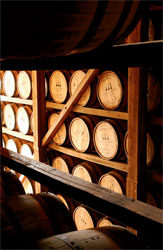Photos by John Nation
One often-overlooked attribute of bourbon whiskey is its approachability — a becoming hint of sweetness that makes it a more accessible drink than the moody, peat-soaked scotches or even the smoothest spirits from Ireland or Canada. That same amiability trickles down to the bourbon distilleries themselves, friendly factories devoted to a time-honored craft and peopled by experienced workers who seem content with the deliberate rhythms of an industry still dedicated to the lessons of the past.
They’re in our own back yard and yet many of us hold them in the same regard as we might the neighborhood’s 200-year-old oak tree: We know they’re there but (we think) they change so slowly that we’re in no hurry to pay a visit. Well, all things considered, distilleries are in a great deal of ferment these days. The rising popularity of small-batch and single-barrel labels is generating a great deal of interest worldwide in the craft of distilling and aging this most distinctive of American whiskeys. And Kentucky’s bourbon makers have responded with an explosion — if such a thing is possible in an industry where most products age up to six years or longer before they hit the market — of new brands, as well as some nifty on-site marketing at the distilleries themselves.
Under the aegis of the Kentucky Distillers’ Association (www.kybourbon.com), six of the nine distilleries in the state have been connected within reasonable driving distance of one another on the “Bourbon Trail,” which was christened in 1999 and counted an estimated 450,000 visitors in 2005. A seventh, Woodford Reserve, does not show up on this whiskey run because its owner, Louisville-based Brown-Forman, not a current member of the association, has chosen to operate its tours independently. All of these facilities have taken steps to demonstrate pride in their craft and enhance its mystique. Most offer regular tours through working production areas, a tasting of selected bottlings, some museum-like exhibits capturing snapshots of the industry’s colorful history, and a gift shop full of logoed items. For Louisvillians, stops on the trail provide indispensable knowledge to pass along to friends, perhaps over a favorite bourbon.
It’s best to think of the state’s distillery tours as two separate day-trips from Louisville, one east toward Frankfort and the Bluegrass, the other south toward Bardstown and tiny Loretto. A good place to start your spirits schooling is at what is touted as the oldest continually operating distillery in the U.S., Buffalo Trace in Frankfort. (Then under the name George T. Stagg, it was one of a handful U.S. spirits plants issued a production license for “medicinal use” during Prohibition, when other distilleries were forced to close). Set along the banks of the Kentucky River, this facility’s barrel-filling days go all the way back to 1787. Until recently, many Kentuckians knew it as the Ancient Age Distillery. Today, its 118 acres hold approximately 100 buildings and visitors are guided through a couple of them.
One of those stops, Bonded Storage Building C, which was built in 1881 when the place was called the Old Fire Copper Distillery, sustained significant wind damage during April 2 storms and was taken off the tour for repairs. Warehouse C — and Warehouse H, which has been acting as its surrogate during the fix-up — contains thousands of 53-gallon charred-oak barrels resting on wooden supports (or “ricks”) that rise six stories to the top of the building. Because higher heat near the top of a warehouse and lower heat near the bottom affect how the whiskey develops, some distilleries rotate their barrels during aging to even out the taste. But Buffalo Trace, with its massive capacity and multiple labels (18 at present), avoids that chore by assigning certain positions to certain bottlings. One of the bourbons manufactured here on contract for other companies, the Pappy Van Winkle 23-year-old, for instance, mellows slowly on the cooler first floor, while the four- to five-year-old Ancient Age matures more quickly with a top-floor resting place.
Other stops on this tour include the Albert B. Blanton Bottling Hall, which features an entertaining display of the multiple and artistic labels affixed at this plant, and the “Free House,” where barrels were stamped for taxing purposes. Buffalo Trace embodies the bourbon industry as just that — an industry. Its 12 large fermentation tanks each hold 93,000 gallons of bubbling sour mash headed for the stills. The stills and fermenters can be seen on “hard-hat tours” that are offered only during this facility’s fall-to-spring whiskey-making season.
A boutique distillery might be just what the bartender orders after such a large-scale operation, and they don’t come any more miniature than Woodford Reserve. The drive from Frankfort is half of the fun if you take a bit of a detour and follow U.S. 60 south to a left, or eastward, turn at Route 1681 (Old Frankfort Pike). The pike takes you past gorgeous horse farms and by some lengthy rock-wall fences, and if you’re hungry, the chance to stop at Wallace Station (see Trip Notes). Make your way back to U.S. 60 and look for the Woodford Reserve Distillery signs at Route 3360 for another few miles of Bluegrass bliss on the way to the historic grounds. Established in 1812 along comely GlennsCreek, this distilling site was used by early liquor luminaries such as Elijah and Oscar Pepper and Dr. James C. Crow; the latter introduced some of the scientific methods still used today in the distillation process. Later known as the Labrot & Graham Distillery, it was purchased by Brown-Forman and reopened in 1996 as a showpiece tourist attraction with copper pot stills, cypress-wood fermenters, tracks for rolling barrels to storage and other anachronisms that help visitors imagine 19th-century whiskey-making. Some of the bourbon produced at this tiny facility is combined with other barrels from Brown-Forman’s Louisville operation and bottled as Woodford Reserve; the rest is a special four-grain recipe sold as Woodford Reserve Master’s Collection. At $5 per person, this National Historic Landmark is the only fee-based tour of the bunch.
A final leg of this eastern distillery jaunt leads to Wild Turkey, which can be accessed off U.S. 62 either from Versailles to its east or Lawrenceburg to its west. You’ll know you’re there when you spot the Kentucky River far below in its limestone-walled valley, the water highway so important in the early shipper-to-sipper trade. This no-nonsense distillery stresses consistency, with a patience revealed by the aging time of its signature brand — Wild Turkey 80 proof — which lolls in the barrel for approximately eight years. The 40-foot-high column still that produces this richly satisfying bourbon is on the tour and master distiller Jimmy Russell says great pains are taken during repairs to match exactly the previous setup. “We could probably change things and maybe not have an effect on the bourbon,” Russell says, “but we’re not willing to take that chance.”
The Spanish mission architecture at Four Roses might make visitors think they’re in wine country, but the tour at this site — just south of Lawrenceburg near the intersection of U.S. 127 and the Bluegrass Parkway — rewards with its focus. The bourbon made here is aged and bottled in Cox’s Creek, so the distillation process commands full attention. A 45-foot-tall copper column “beer” still and 16,000-gallon, red-cypress fermentation tanks add class to this National Register of Historic Places facility, which was built in 1911. (Wooden tubs have been replaced by stainless steel in most distilleries for easier maintenance, but Register status compels Four Roses to keep using cypress.) Visitors may taste the clear “new whiskey” straight from “tail boxes” on the beer still and the adjacent “doubler,” which raises its proof from 130 to 138. It’ll give you the burn of moonshine — in this case, a highly refined one.
The more-southern route of the Bourbon Trail runs first through Jim Beam, which is located off I-65 South across from BernheimForest on Hwy. 245 in Clermont. This distillery, the bourbon industry’s largest, also gives the best on-site history lesson at its American Outpost. The Beams should know their history — current master distiller Fred Noe is seventh in a line of Beam-family Kentucky whiskey-makers that goes back to the late 1700s. Visit the reconstructed 19th-century cooperage shop and gaze at one of the oldest stills in America, a tarnished copper pot still that predates the 1794 Whiskey Rebellion. No tours are offered here, but the exhibits will prep you for upcoming stops.
For more of a history fix, follow 245 southeast into Bardstown and visit the Oscar Getz Museum of Whiskey History, or loop around My Old Kentucky Home to Hwy. 49 South and Heaven Hill, site of a 10,000-square-foot heritage center that opened in 2004. It carries the theme into even the building materials — limestone walls, oak floors and a copper roof — which evoke images of clear water, charred barrels and early pot stills, all contributors to bourbon’s uniqueness. This distillery focuses its tour on one stop at Warehouse Y, providing detail on the aging process in which colorless “new” whiskey interacts with the wooden barrel to produce a caramel color and complex flavors. There are 20,000 barrels in Warehouse Y stacked in an “open-rick”system, and visitors walk among them intoxicated with the unforgettable aroma of bourbon-in-the-making.
The final jaunt along Hwy. 49 South to sleepy Loretto and Maker’s Mark sets the stage for more bourbon romance. Unlike the huge facilities at Jim Beam and Heaven Hill, this distilling village is a picture-postcard setting with more than 350 plant species represented on the arboretum-like grounds and tours through several of the perfectly painted, residence-like buildings. Bill Samuels Sr. took over this facility, which was opened as a gristmill and distillery in 1805, and started aging the first small-batch bourbon here in the early 1950s. It remains the only product that comes out of the copper still, and visitors can soak up a true appreciation of the craft in the Distiller’s House, where the entire bourbon-making process — from the milling of grains to their fermentation with yeast to distillation — are all executed under one roof. Your education will be complete.
 |  |  |
|---|---|---|
 |  | Time-honored production: Tours take visitors through a Woodford Reserve warehouse (facing page). Other sights include (clockwise from above) the cypress-wood fermenters and bottling line at Maker’s Mark, Buffalo Trace in Frankfort, a handful of sour mash and the Cistern Room where barrels are filled at Wild Turkey. |


